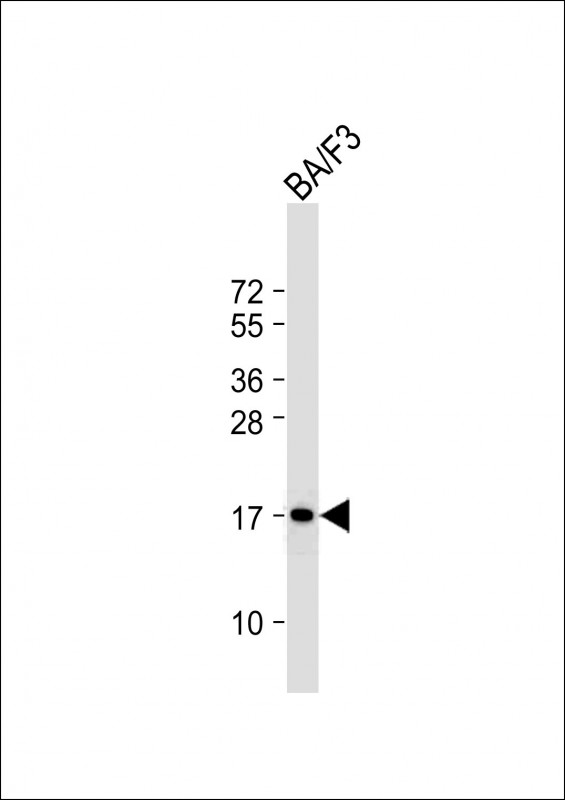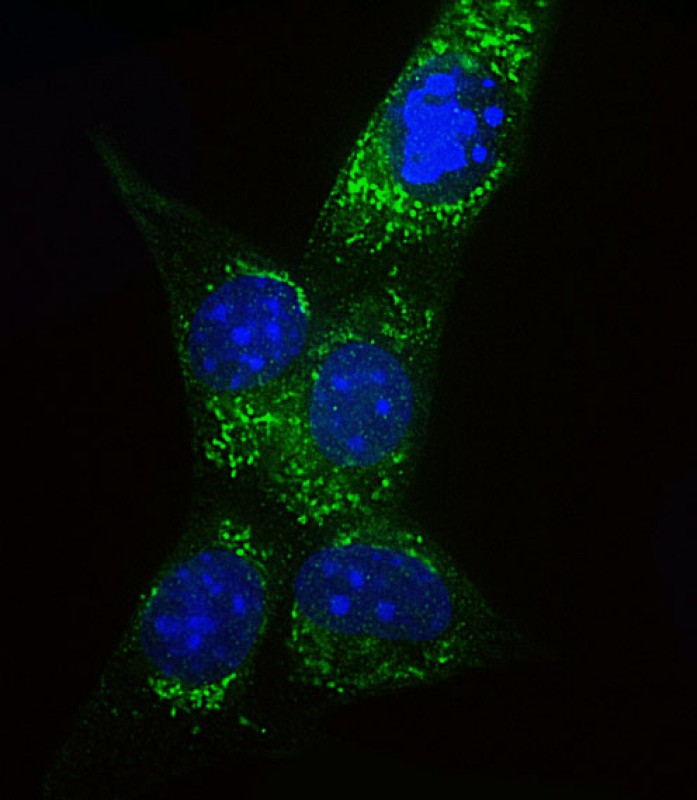

| WB | 咨询技术 | Human,Mouse,Rat |
| IF | 咨询技术 | Human,Mouse,Rat |
| IHC | 咨询技术 | Human,Mouse,Rat |
| ICC | 1/25 | Human,Mouse,Rat |
| FCM | 咨询技术 | Human,Mouse,Rat |
| Elisa | 咨询技术 | Human,Mouse,Rat |
| Aliases | Cytochrome c oxidase subunit 4 isoform 1, mitochondrial, Cytochrome c oxidase polypeptide IV, Cytochrome c oxidase subunit IV isoform 1, COX IV-1, Cox4i1, Cox4, Cox4a |
| Entrez GeneID | 12857 |
| WB Predicted band size | 19.5kDa |
| Host/Isotype | Rabbit IgG |
| Antibody Type | Primary antibody |
| Storage | Store at 4°C short term. Aliquot and store at -20°C long term. Avoid freeze/thaw cycles. |
| Species Reactivity | Human, Mouse, Rat |
| Immunogen | This COXIV antibody is generated from a rabbit immunized with a KLH conjugated synthetic peptide between 49-83 amino acids from the mouse region of mouse COXIV. |
+ +
以下是关于COXIV抗体的模拟参考文献示例(仅供参考,建议通过学术数据库获取真实文献):
---
1. **文献名称**:*Cytochrome c oxidase subunit IV as a mitochondrial loading control in Western blot analysis*
**作者**:Thompson, L.M., et al.
**摘要**:本研究验证了COXIV抗体作为线粒体蛋白内参的可靠性,通过比较不同组织样本中的COXIV表达稳定性,证明其在标准化线粒体含量分析中的适用性,尤其在癌症和代谢疾病模型中。
2. **文献名称**:*Immunohistochemical detection of COXIV in Alzheimer’s disease brain tissues*
**作者**:Chen, H., & Harper, D.G.
**摘要**:利用COXIV抗体对阿尔茨海默病模型小鼠脑组织进行免疫组化分析,发现线粒体功能障碍区域COXIV表达显著降低,提示其与神经退行性病变的相关性。
3. **文献名称**:*Comparative evaluation of commercial COXIV antibodies for specificity and sensitivity*
**作者**:Rodriguez, J.E., et al.
**摘要**:系统评估了多种市售COXIV抗体的性能,通过siRNA敲低实验和跨物种交叉反应测试,推荐了适用于不同实验场景(如流式细胞术、免疫荧光)的高效抗体。
4. **文献名称**:*COXIV overexpression correlates with chemoresistance in colorectal cancer*
**作者**:Wang, Y., et al.
**摘要**:通过COXIV抗体检测结直肠癌患者的肿瘤组织,发现高表达COXIV与线粒体代谢重编程及化疗耐药性相关,为靶向治疗提供了潜在标志物。
---
**备注**:以上文献为模拟示例,实际引用时请通过PubMed、Web of Science等平台检索真实文献(关键词:COXIV antibody, cytochrome c oxidase subunit IV, mitochondrial markers)。
COX IV (Cytochrome c Oxidase Subunit IV) is a key component of Complex IV (cytochrome c oxidase), the terminal enzyme in the mitochondrial electron transport chain (ETC) responsible for catalyzing oxygen reduction and proton pumping across the inner mitochondrial membrane. As a nuclear-encoded subunit, COX IV is critical for the assembly, stability, and catalytic activity of Complex IV. Its expression is often used as a mitochondrial marker due to its consistent presence across tissues, reflecting mitochondrial abundance and integrity.
COX IV antibodies are widely employed in research to study mitochondrial function, biogenesis, and dynamics. They are essential tools in techniques like Western blotting, immunofluorescence, and immunohistochemistry to validate mitochondrial enrichment in subcellular fractionation or to assess mitochondrial content changes in diseases such as neurodegeneration, cancer, and metabolic disorders. Unlike cytoplasmic housekeeping proteins (e.g., β-actin), COX IV serves as a preferred loading control for mitochondrial proteins, minimizing variability from experimental conditions affecting cytoplasmic markers.
Additionally, COX IV exists as tissue-specific isoforms (IV-1 and IV-2), with IV-1 ubiquitously expressed and IV-2 enriched in lung and endocrine tissues. Studies using isoform-specific antibodies help explore functional adaptations in energy metabolism across different cell types. Overall, COX IV antibodies are indispensable for elucidating mitochondrial physiology and pathology.
×